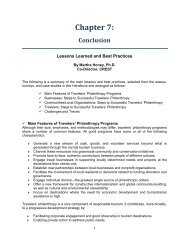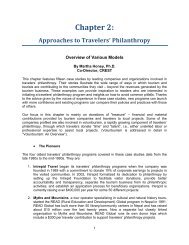Travelers' Philanthropy Handbook - Center for Responsible Travel
Travelers' Philanthropy Handbook - Center for Responsible Travel
Travelers' Philanthropy Handbook - Center for Responsible Travel
Create successful ePaper yourself
Turn your PDF publications into a flip-book with our unique Google optimized e-Paper software.
• A Note of CautionWhile there is a clear need <strong>for</strong> the resources that travelers’ philanthropy can generate, goodoutcomes are not guaranteed. CREST believes that travelers’ philanthropy programs shouldemphasize the quality not the quantity of partnerships between tourism businesses, travelers,and local community projects. While the research and case studies in this <strong>Handbook</strong>demonstrate that people contribute more if they actually see a project and meet with localpeople (rather than simply reading about a project on a website), these interactions need to becarefully planned. We are very aware that ‘doing good’ does not always mean ‘doing right’.Experience has shown the downsides to philanthropy and voluntourism, if it is done poorly(failed projects, corruption, broken promises, divisions in the local community, inappropriategifts, etc.). See, <strong>for</strong> instance, examples of “Unwanted <strong>Philanthropy</strong>” in Chapter 6. Here are acouple more examples:oooIn response to a tourist’s request drop in on an orphanage <strong>for</strong> a few hours, atour operator in Cambodia replied, “Children are not pets. Orphanages are notzoos.”A notice posted in a tourism van in East Africa and signed by the Director of theWorld Health Dental Organization, read: “WARNING: Please DO NOT givecandy (sweets) to the Maasai children. They are unprotected without fluorides,toothbrushes, painkillers and dentists. TOURISTS WHO GIVE SWEETS ARECAUSING MAJOR TOOTH DECAY AND SUFFERING!”A school in South Africa received a dozen computers from a well meaningAmerican, sent via a safari company as part of their travelers’ philanthropyprogram. Several years later, the computers still laid piled in the corner of aclassroom because the school had no electricity.As David Abernethy’s essay in Chapter 6 details, good intentions can have unintended negativeconsequences, especially when the interaction is between people from vastly different economicand cultural backgrounds. CREST’s publication, “Dos and Don’ts of <strong>Travel</strong> Giving” (seeAppendix 1) is intended to help travelers think critically about the potential impacts of their urgesto help. Similarly, the “Voluntourism Operator Check List” is designed to help tour operators toeffectively integrate volunteer projects into their trips (Appendix 2). <strong>Travel</strong>er education isessential <strong>for</strong> channeling well-meaning offers to help into responsible donations <strong>for</strong> sustainablecommunity projects.• How Much is <strong>Travel</strong>ers’ <strong>Philanthropy</strong> Contributing?Nobody knows. That is the conclusion of CREST’s research, including of the surveys, essays,and case studies commissioned <strong>for</strong> this <strong>Handbook</strong>. It is also the conclusion of the 2009 “<strong>Travel</strong><strong>Philanthropy</strong> Report” commissioned by the World <strong>Travel</strong> Market (WTM). As this report states:Most companies keep no records and very few have systems in place to be able toeasily report how much is raised by companies, staff and travelers…. There is10















